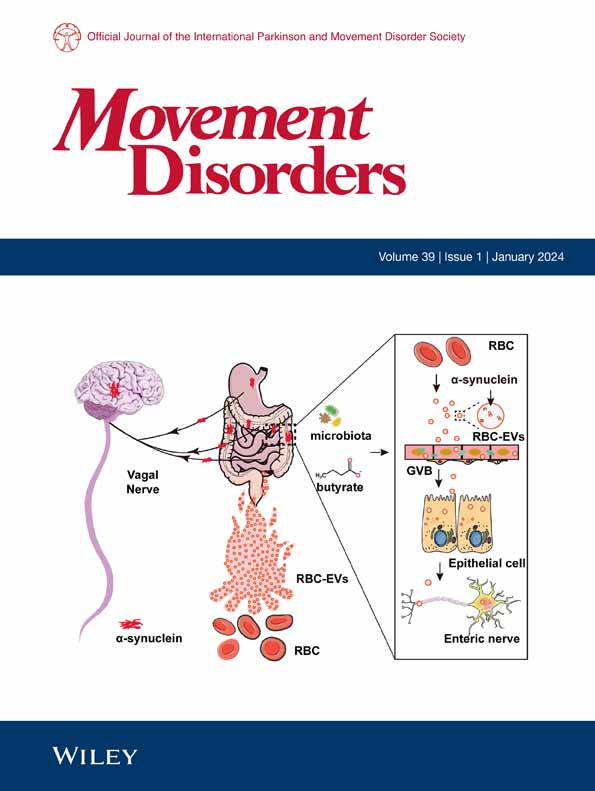通过低频重复性躯体感觉刺激改善局灶性手部肌张力障碍症
IF 7.4
1区 医学
Q1 CLINICAL NEUROLOGY
引用次数: 0
摘要
背景肌张力障碍是一个日益受到关注的问题,其发病率也在不断提高。以前的研究发现,在颈性肌张力障碍患者中,对数字神经进行高频重复体感刺激(RSS;HF-RSS)会自相矛盾地削弱感觉运动抑制机制,而低频重复体感刺激(LF-RSS)则会增强这种机制。本研究旨在探讨直接在局灶性手部肌张力障碍患者的前臂肌肉上施加 RSS 是否会调节大脑皮层的抑制机制和临床症状。方法我们在肌张力障碍患者的前臂肌肉上施加高频 RSS 和低频 RSS,后者可同步或非同步施加。结果测量包括成对脉冲体感诱发电位、双脉冲体感诱发电位测量的空间侧向抑制、经颅磁刺激测试的皮层内短抑制、肌张力障碍肌肉的肌电活动以及手部功能的行为测量。结果同步和异步低频躯体感觉刺激都能改善大脑皮层的抑制性相互作用,表现为皮层内短抑制和侧向空间抑制的增强,以及成对脉冲躯体感觉诱发电位振幅的降低。高频刺激则产生了相反的效果。我们的研究结果证实,肌张力障碍患者的感觉运动系统(尤其是抑制回路)在对 RSS 的反应中存在异常的静态可塑性。重要的是,这种异常反应可以通过直接对肌张力障碍肌肉进行低频电刺激达到治疗目的。©2024年作者。运动障碍》由 Wiley Periodicals LLC 代表国际帕金森和运动障碍协会出版。本文章由计算机程序翻译,如有差异,请以英文原文为准。
Amelioration of Focal Hand Dystonia via Low-Frequency Repetitive Somatosensory Stimulation.
BACKGROUND
Dystonia presents a growing concern based on evolving prevalence insights. Previous research found that, in cervical dystonia, high-frequency repetitive somatosensory stimulation (RSS; HF-RSS) applied on digital nerves paradoxically diminishes sensorimotor inhibitory mechanisms, whereas low-frequency RSS (LF-RSS) increases them. However, direct testing on affected body parts was not conducted.
OBJECTIVE
This study aims to investigate whether RSS applied directly to forearm muscles involved in focal hand dystonia can modulate cortical inhibitory mechanisms and clinical symptoms.
METHODS
We applied HF-RSS and LF-RSS, the latter either synchronously or asynchronously, on forearm muscles involved in dystonia. Outcome measures included paired-pulse somatosensory evoked potentials, spatial lateral inhibition measured by double-pulse somatosensory evoked potentials, short intracortical inhibition tested with transcranial magnetic stimulation, electromyographic activity from dystonic muscles, and behavioral measures of hand function.
RESULTS
Both synchronous and asynchronous low-frequency somatosensory stimulation improved cortical inhibitory interactions, indicated by increased short intracortical inhibition and lateral spatial inhibition, as well as decreased amplitude of paired-pulse somatosensory evoked potentials. Opposite effects were observed with high-frequency stimulation. Changes in electrophysiological markers were paralleled by behavioral outcomes: although low-frequency stimulations improved hand function tests and reduced activation of dystonic muscles, high-frequency stimulation operated in an opposite direction.
CONCLUSIONS
Our findings confirm the presence of abnormal homeostatic plasticity in response to RSS in the sensorimotor system of patients with dystonia, specifically in inhibitory circuits. Importantly, this aberrant response can be harnessed for therapeutic purposes through the application of low-frequency electrical stimulation directly over dystonic muscles. © 2024 The Author(s). Movement Disorders published by Wiley Periodicals LLC on behalf of International Parkinson and Movement Disorder Society.
求助全文
通过发布文献求助,成功后即可免费获取论文全文。
去求助
来源期刊

Movement Disorders
医学-临床神经学
CiteScore
13.30
自引率
8.10%
发文量
371
审稿时长
12 months
期刊介绍:
Movement Disorders publishes a variety of content types including Reviews, Viewpoints, Full Length Articles, Historical Reports, Brief Reports, and Letters. The journal considers original manuscripts on topics related to the diagnosis, therapeutics, pharmacology, biochemistry, physiology, etiology, genetics, and epidemiology of movement disorders. Appropriate topics include Parkinsonism, Chorea, Tremors, Dystonia, Myoclonus, Tics, Tardive Dyskinesia, Spasticity, and Ataxia.
 求助内容:
求助内容: 应助结果提醒方式:
应助结果提醒方式:


